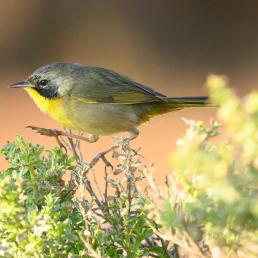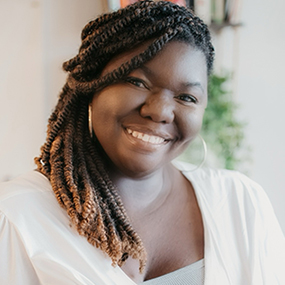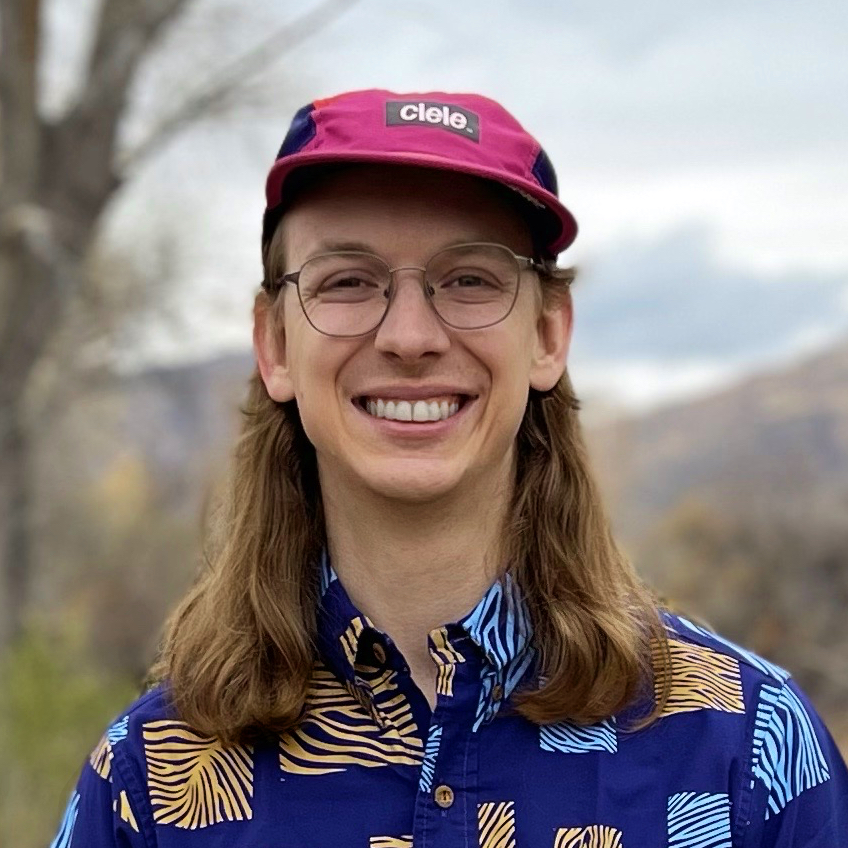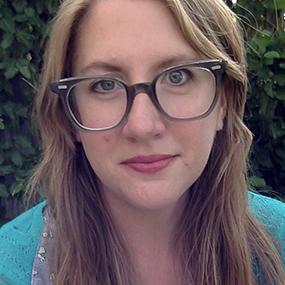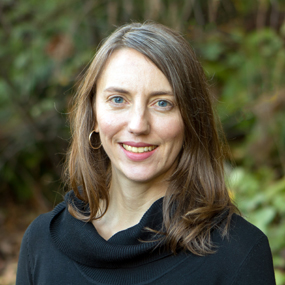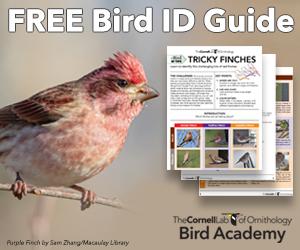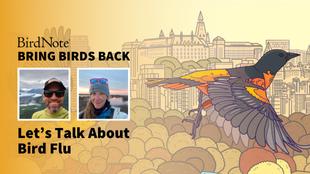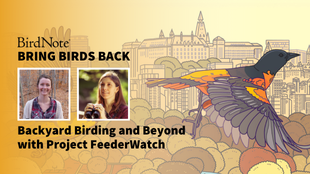

Join BirdNote tomorrow, November 30th!
Illustrator David Sibley and actor H. Jon Benjamin will face off in the bird illustration battle of the century during BirdNote's Year-end Celebration and Auction!
In the third installment of Bring Birds Back, host Tenijah Hamilton talks with NYC Audubon Senior Conservation Biologist Kaitlyn Parkins and Seattle Audubon Urban Conservation Manager Joshua Morris to break down the challenge that glass in our built environment poses to birds, how a local solution is becoming a national policy, and what you can do to support it.
Tenijah Hamilton: BirdNote Presents.
From BirdNote, this is Bring Birds Back. I’m Tenijah Hamilton.
So a couple of years back, I was living in New Zealand. And I was staying with some friends — big shout out to Melissa and Mike. Their house has these beautiful windows and glass doors, and it is absolutely gorgeous. And on this particular day, my best friend Misha had flown in from the states and we were hanging, just before a night out. Just having conversation, minding our business in this beautiful landscape, and this little tiny bird... thud, hit the window. For some context here, Misha is… I don’t want to say she’s afraid of birds, but that would be the closest to the truth. And this bird had flown into the window first and then managed to come through the open backyard door into the house.
I'm startled. The bird’s startled. My best friend has mild conniptions. We don't really know what to do here. This bird is freaking out. He keeps repeatedly flying into the window. He’s hitting it cause he's trying to get outside, but it's not outside, it’s glass! And so we're panicking and I'm chasing the bird around the house. I'm trying to cup it in my hands, but then I'm like, is that the right thing to do? What if I hurt it even more? It was a whole fiasco. And eventually we manage, I say, we, we, we did not do anything for the record. It was just me. My best friend Misha, love her to death… she was no help. I managed to gently guide the poor little guy out of the house.
This was a notable experience for a couple of reasons. I’m decently sure Misha’s life flashed before her eyes, and I mean, what an awkward eulogy that would have been to give right? And for me, I’ve mentioned how birds were always relegated to the background in my life. Sure, I knew they were there, and I even liked that they were there, but I didn’t think about them much. But here, I had a bird who had literally flown into the foreground and I felt pretty helpless to get him back on his feet. This was a first for me.
But it turns out what caused the whole incident, the bird colliding with a window? This is a super common, and huge problem for birds. As many as one BILLION birds are killed by window collisions in the US each year. That is a wild number of birds, making it the second largest man-made cause of death for birds here in the states.
Fortunately, there are some solutions, both in making existing windows safer and in building smarter in the future. To talk about all of this we have two fantastic guests today. Let’s dive right in...
Tenijah Hamilton: Joshua Morris is the urban conservation manager for Seattle Audubon and is spearheading their Bird Safe Cities initiative.
Josh Morris: Thanks Tenijah, it's great to be here.
Tenijah Hamilton: And Kaitlyn Parkins is a senior conservation biologist for New York city Audubon. Thank you so much for being here. We're really excited.
Kaitlyn Parkins: Thanks for having us.
Tenijah Hamilton: Absolutely. So I would love it if y'all could just take a step back. And so we have this issue where these birds are flying into windows. Why does this happen and why is it so dangerous?
Kaitlyn Parkins: So glass is made to be see-through, right? People can't really see it either. I think a lot of folks have a story of someone they know, or maybe themselves or a pet walking into a glass window, and then you learn about it. And you're a little more careful the next time. You use architectural cues to detect where glass is. So, a door handle or something like that. And birds just don't perceive the world like we do. Birds might see habitat reflected in glass. So trees or bushes, somewhere they think is good habitat and fly into it. Or you can have two panes of windows lined up in a way that birds can see all the way through to the other side, so if you can imagine glass walkways or things like that. And so birds fly really fast and they often hit glass really hard and don't have a chance to learn about it because they die upon impact or shortly thereafter. And songbirds are particularly prone to collisions with windows. They migrate twice a year. They move through areas, such as large cities. So they're moving through new and unfamiliar habitats twice a year and they migrate at night and they have to stop over on migration. And sometimes they end up in these places during stopover, where they're just surrounded by reflective glass. And it is a pretty big issue. Now I'm from New York city. So I'm a little bit biased. We work with a lot of big buildings. Um, but it's actually not just a tall skyscraper issue. Low rise buildings, homes are actually the biggest killer of birds because there are far more of them, you know, distributed across the country.
Tenijah Hamilton: Wow. So I am kind of surprised that this isn’t just a city or a skyscraper issue, but it totally makes sense that there are just way more smaller buildings. So it seems like, whatever kind of building you live in, if you have windows… you should be thinking about this, right? What kind of solutions are out there? What can I or our listeners do to make their house or apartment safe for the birds?
Josh Morris: I really like working on bird window collisions because unlike some other environmental challenges, like climate change, which are such wicked huge problems where so many things need to change all at once, solutions to bird window collisions actually seem a little less complicated. And the solution is: just help birds see windows. Usually you do that by applying some kind of patterning or a vinyl sticker or something on the exterior surface of your window to create what people sometimes call visual noise, to help birds detect the window as an actual barrier. And there's a general rule to help people, and that's the two by two rule, where you apply patterning or stickers in a way such that there's no gap of exposed glass greater than two inches by two inches. That's too close for comfort for most birds. There are products that are relatively small in size and so minimal that your eye can just focus past them and you hardly even know they're there. Like Feather Friendly dots, they're just one-eighth square-inch dots that you apply on, on the surface of your window. You hardly notice them once they're installed. It's not going to prevent all collisions, but it's been shown to be pretty effective.
Tenijah Hamilton: Okay. So when you say like that, like, Josh, that seems easy enough. Why isn't everybody doing it? And how do we change that?
Josh Morris: That's a good question. And some of it is that awareness is kind of lacking about the issue. For most people, this problem presents itself once, twice a year at their home, but that doesn't feel big to a lot of people, you know, and not worth really thinking about maybe for a lot of people who, who haven't thought about the multiplier effect of all those millions and millions and millions of structures that have one, two birds a year hitting them. So I think that would be a big reason. There's not the awareness of how big an issue this actually is.
Kaitlyn Parkins: That's precisely what I was going to say, Josh. People just can't really understand the magnitude of the issue, especially if they're only seeing one bird on the sidewalk or outside the window of their home every, you know, couple of weeks or couple months. I remember growing up in Maryland, my dad and step-mother had this giant picture window. And every once in a while we would hear a thump. And I would be like, "oh, a bird hit the window". It was usually Cardinals and we’re like, "that's so sad. Okay. Onto the next thing", like it was just a normal thing. And so I think a lot of people have that experience, but it wasn't until I was actually working on collisions as a scientist, that I realized how much that adds up and how big of an issue it is.
Tenijah Hamilton: So, okay, in our first episode we got to speak with a biostatistician named Adam C. Smith, and he was one of the people who helped to crunch those numbers and came up with the 3 billion bird figure. And some of the things he talked about was the importance of community science in determining how bird populations are going. So people go out and they survey on a regular basis and they determine how many birds are in a given area. It's all very sweet and cuddly. And like you're doing good for the community... Y'all are kind of, doing the dark side of that work.
Kaitlyn Parkins: [Laughs]
Tenijah Hamilton: Kaitlyn, what is dBird and how did it start?
Kaitlyn Parkins: Yeah, So New York city Audubon, we've been doing collision monitoring, like formal volunteer collision monitoring since 1999. Which means we have volunteers who are committed to going out and surveying a route every single week and counting the birds and putting in effort. And we've been doing that for a long time and it's helped us learn a lot about collisions. But when I was an intern and another intern was working with us, we also realized that we would get a lot of calls to the office. People who found injured birds and wanted to know what to do with them, and people who found dead birds and wanted to know what was going on. And the staff at the time would answer the phone and they would write that down in a word document or on a piece of paper and go put it in a file somewhere. Or in my case, like I just had sticky notes with, like species of birds and cross streets written on them, like strewn across my computer and my desk. And another intern, Darren Klein was taking a class on web-based mapping. And he started to think, like, "this is still valuable data. There's gotta be a way we can collect it". And that's sort of how dBird was born. At first, it was just like a Google form with like a little custom map interface. And Darren took that to the next level and created a dBird program, where people could just report collisions. What we wanted was something that didn't require a username and a password. That was sort of the barrier to reporting. You know, we'd like to think everyone cares about birds as much as we do, and unfortunately that's just not the case. So we want to get those reports from people who, you know, are walking to work and see a dead bird and just want to do something with that information, but don't want to commit too much. And so, yeah, that's how dBird was born
Tenijah Hamilton: That is very cool. So, essentially, in addition to those dedicated volunteers, dBird opens that up to anyone to log bird collisions?
Kaitlyn Parkins: Yeah, dBird allows an even bigger group of people to participate because you don't have to commit to doing a specific route or a specific time. So those folks can be people who just know about dBird in are on the lookout for collisions. They don't even necessarily have to commit or over-commit potentially.
Tenijah Hamilton: And then y'all, working on this issue, had a pretty big victory recently. Can you tell me a little bit about that? Go ahead, brag a little!
Kaitlyn Parkins: Yeah. New York city passed landmark collisions legislation back in 2019, which was a really long time coming and really built on the work of staff and volunteers before us. But one of the things that helped us get that legislation passed was being able to really show the magnitude of the collision issues in New York city and dBird was instrumental because we could just map all the incidental collisions. And you see little red dots on a map, and as they keep coming in and added essentially in New York city turns into a big red blob of collision marks.
That visual, I think, really struck people and our legislators and helped get that legislation passed. And, you know, we really wanted to expand dBird and make it useful for others to use, so that other communities could see the same success in this realm that New York city has.
Tenijah Hamilton: As of December 2020, any new buildings or major renovations in New York City need to meet bird-safe building standards. It requires patterned glass or safe materials to be used where birds are most likely to be flying — the first 75 feet of a building, and above any green-roofing. That ask is easier on developers and architects, while still making a huge difference for the birds. This is some of the strongest bird safe legislation in the country. And it was only possible with the years of data collected by Audubon volunteers and everyday users of dBird.
After the break, we’re going to talk about the big update Seattle Audubon has done to dBird so it can work everywhere — and hopefully spur similar legislation all across the country. That’s after this.
Tenijah Hamilton: So dBird allowed folks like Kaitlyn at NYC Audubon to collect and analyze a lot of great data, both from dedicated collision monitors and from anyone encountering a bird that’s had a window collision. And that data was crucial in passing groundbreaking bird-safe building legislation. So naturally, there’s been interest in bringing dBird to other places so that they might replicate New York’s success. But dBird was pretty New York specific in how it was built. Kaitlyn says it was starting to show its age...
Kaitlyn Parkins: It was really good at the time! And then over the years, became held together with, like, glue and gum and, like, tape on the back end and it really needed an update. and we just wanted to make it more useful. And, and that's where Seattle Audubon and Josh came in. Josh asked me if he could just, like, pick my brain about collisions, because I've been working on it for a while now. And you know, we chatted for a while and I brought up dBird and I was like, "we've been trying to make it easier for other groups to use. We've been trying to fundraise to get a developer to update it". And Josh was like, “Oh, you know, maybe we could help with that.” And I was like, "yeah, yeah, maybe". I've heard that before, and the fact that it worked out, it is incredible.
Josh Morris: Yeah. One of my favorite things about this interview is that the expansion was actually inspired by a BirdNote story. Jim and Birte Falconer were the funders. Jim got in touch with us after he heard a story about collisions on BirdNote and he was curious what was happening locally with the issue and the answer at the time was nothing. There weren't any organizations in the city of Seattle that were thinking about collisions in a serious way. And a big part of improving our understanding was being able to provide an opportunity for people to submit incidental mortality reports. And the funders were really excited to see something that would have benefits beyond Seattle and be useful to more than one organization in one location. So dBird is really perfect for that.
Kaitlyn Parkins: Yeah, I love how dBird is, like a lot of different stars aligned story. Um, because it really is.
Tenijah Hamilton: I was just thinking that. I was like “Look! Look at that. That’s so awesome.” And then here you are.
Kaitlyn Parkins: But yeah, I'm hyped that you guys are doing this out in Seattle. To go from like, just this dinky little project that we were working on back in 2013, myself and another intern, you know — he had the programming knowledge and I had the bird knowledge and like to see now, we're getting sign ups for dBird from all across the country, is really exciting.
Tenijah Hamilton: I love that. And I love that you called it your dinky project.
Kaitlyn Parkins: Darren's gonna kill me. "What do you mean!? It wasn't dinky, it was great!"
Tenijah Hamilton: So I'm curious now, so I want to use dBird. Can you describe the process? Like, walk me through how I log a bird that I find, how would I do that?
Kaitlyn Parkins: So it's super simple. You go to dBird.org. There's a map and you can type in the address where you are, or if you're using it on your phone, you hit get my location and I'll zoom right in on you. Select the species of bird that you found, or you can say you don't know what kind of bird you found. You can then indicate the age and sex if you know it. And then, you can attach a photograph of the bird, if you'd like and hit submit, and you're good to go.
Tenijah Hamilton: Amazing, that is so easy! So Josh, now that dBird is adaptable to other cities… How is it going in Seattle?
Josh Morris: We just announced the launch of dBird to Seattle at the beginning of April, so we're still developing our user base. Many of the people who have already submitted reports are Audubon supporters. They're people who feed birds and have experienced collisions at their homes. But just today I got a report of a Cooper's Hawk that struck a building in one of our most densely populated neighborhoods, Capitol Hill in Seattle. And I went to go collect it from him so that I could take it over to the Burke Museum for their collection and I asked him how he heard about dBird, and why he reported it. And he wasn't a Seattle Audubon member, he didn't know anybody who was. He just experienced this loss of a Cooper's Hawk striking his window and then finding it on his walkway. It was a juvenile female, and just a big, beautiful bird. And I think he felt a loss and that it deserved to be memorialized in some way, and just thought there has to be a way to report this to someone. And so he did a little Googling and eventually came across dBird and reported it. and that's what's so powerful about dBird is, because there is no password or login, people who have this moment of motivation to do something can just do so with such little effort. And then you end up making these connections. So we're still building out the local user base out here in Seattle, but I'm really hopeful that it's going to grow to include a wide range of diverse users.
Tenijah Hamilton: That's so awesome. How does that feel, kind of, on the backend, like "I'm creating this thing that helps solve this issue and people are using it. People are actually doing the work and reporting it". How does that feel?
Josh Morris: It feels really exciting, but it feels almost perverse in a way, like when, when people are reporting dead birds and then I get excited and it's like, "Oh three dead crows". But yeah, I mean, the issue is just so understudied in Seattle, in the Pacific Northwest, on the West coast. A lot of the areas where collisions have been, have been studied are coming from the East coast or the Midwest or Canada. And so to feel like we're starting to build out something here in Seattle is really exciting.
And it makes me hopeful that we'll be able to tell some compelling stories from the data and the maps that are generated from dBird because people are storytellers and people want to be told a story. And if I just say, "collisions are a problem in New York city". You know, I don't know if that's going to motivate a city council member in Seattle to pass some bird safe building legislation out here.
Kaitlyn Parkins: Yeah. And that was really well said, Josh. I think that, when people find dead birds, specifically — if you find an injured bird, there are ways that you can help that bird and it gives you something to do. But when you find a dead bird
we would get calls a lot that would be like, "what do I do?" And, you know, the appropriate thing to do with an animal carcass in a city is put it in a plastic bag and tie it up and put it in the trash can. And that was just devastating for people. And so I think dBird also offered them a way of doing something that would make them feel like they were helping with the issue instead of just having to walk by or throw the bird away.
Tenijah Hamilton: So, okay. So tell me a little bit more about, what benefits does dBird bring? Like what do we gain as a community from doing this work?
Josh Morris: We've got a pretty limited understanding of collisions in Seattle. What we do know comes from our local wildlife rehabber, PAWS, up in Lynnwood. They've treated over 1100 collision victims in the past 10 years, 84 different bird species. Collisions are occurring year round. And it's happening all across the region. But that represents just the tiniest tip of the iceberg, being those that were detected, those that were still alive and might be treatable, and those that somebody cared enough about to take to the hospital. So I'm just excited to start fleshing that out a little bit more. dBird is helpful for us because we do want to set up a robust collision monitoring program, like New York city Audubon has with Project Safe Flight. And to help guide that we're hopeful that dBird might show us where some problematic buildings are. Or if there are times of year where there just appear to be many more reports coming in and other times a year. So we might focus our time and attention on those buildings during those months. So helping guide some more scientific research is going to be really helpful for us.
Kaitlyn Parkins: Yeah. I mean, I see dBird from a scientific perspective because I'm a scientist. I hope that dBird allows us to learn more about collisions. I am currently manipulating some dBird data in order to find the best potential dates for a lights out policy to be instituted in New York city. For many reasons, including human health, but from the bird perspective, we're looking at dBird data to see when would the best time be for buildings to turn their lights out during migration, and then, an okay time for them to come back on.
Tenijah Hamilton: Awesome. Okay. So the updated dBird is part of this much larger Bird Safe Cities initiative starting from Seattle Audubon. So Josh, can talk a little bit more about the program and the three different parts that kind of go into it?
Josh Morris: Yeah, sure. So dBird fits into the first component of our Bird Safe Cities initiative, which is to improve the local understanding of collisions in Seattle. And there are actually three components of that. One was dBird. To provide a way to collect incidents of reports on collision mortality. The second is to use the insights that we can glean from dBird, and from local experts to develop a more robust collision monitoring effort. And then third is to try to capture some of the more human, emotional aspects of collisions just through a story gathering campaign.
Tenijah Hamilton: Right.
Josh Morris: So we've been asking people, you know, if you've experienced a collision, please report it through this story collection tool that we've got on our website under our advocacy page. And that's also been interesting too, cause you can, you know, develop your word clouds and things like sad, heartbreaking, devastating, rise to the top. So the issue isn't just on birds. This is something that, you know, emotionally affects people too.
Kaitlyn Parkins: I'm sorry, I didn't realize you were collecting that information. People sometimes leave notes and like sometimes they personally address them to me in the notes section of dBird and I never thought about putting a word cloud together. That's brilliant. Now I want to go do that. I'm about to work all night on a Friday night and go do that.
Tenijah Hamilton: Well, I'm curious if, you know, New York city saw this legislation to require buildings to be safer for birds, and I’m curious, is there anything like this happening like this in other cities around the nation? Like, what are we seeing in other states?
Josh Morris: There are dozens of efforts going on. Yes.
Tenijah Hamilton: That’s the happy answer.
Josh Morris: Yeah. There's Bird Safe building legislation passed or pending in over 30 places, I think. Including at the national level. Here in the U.S., representative Quigley from Illinois, has introduced a bird safe buildings act. I think this is his 11th year in a row that he's reintroduced it and it would require any buildings acquired, constructed or substantially altered by the general services administration to meet bird safe building standards. So it’s scope is kind of limited, but it would set an amazing precedent and create some demand and some thinking among developers for bird safe building standards. So Seattle Audubon for sure, is advocating for the Bird Safe Buildings Act of 2021. And I'd encourage anybody else to write to their US legislators and ask them to co-sponsor and support that. But then of course there are a lot of local work that's going on. I just heard from a member of the collision working group, that Cupertino just passed a Bird Safe building ordinance. Lots of good work has been happening, and I hope to get Seattle to follow soon.
Kaitlyn Parkins: Yeah, I think we're going to soon hopefully reach sort of, a critical tipping point in bird safe legislation. Like, clearly it needs to be legislated everywhere, but when the New York City bill got passed, all of a sudden, manufacturers and like, materials developers started coming to us and asking about the types of bird friendly materials they can manufacture. There's been interest from glass manufacturers in making all sorts of different kinds of patterned glass that is bird friendly, or could potentially be bird friendly. And so the more legislation that's passed, I think the more demand there is from people, even in places where legislation hasn't been passed, the more materials there are and the cheaper those materials get, so that cost isn't sort of a barrier constructing bird friendly buildings. And so, every city, every town, every ordinance, is getting us to that, that tipping point.
Tenijah Hamilton: I am really heartened to know that y'all are out here doing the work and making it safer for the birds to do their thing.
Josh Morris: It’s the least we can do.
Kaitlyn Parkins: Yeah. Yeah, absolutely. And you know, a critical other media outlets. We need all the pieces of the puzzle to come together so that we can make it happen.
Tenijah Hamilton: I love that. Thank you both so much. This has been a lot of fun, and we learned so much about dBird.
Kaitlyn Parkins: Thanks for having us
Josh Morris: Yes, this was really fun
Tenijah Hamilton: New York City is just one tiny fraction of windows birds pass on their long migrations. But it sets a precedent, and it creates real demand for special, bird-safe glass. If we can gather data to convince city councils in more cities, like Seattle or Chicago or Atlanta — that impact grows. By helping to understand the issue better, dBird can not only give a sense of meaning to encountering a dead bird — it can help make a meaningful difference in creating a world where window collisions are a thing of the past.
You can take part in dBird by going to dBird.org. And for resources on how to make your home or apartment safe for birds, we’ve got you, and your windows, covered at BirdNote.org.
Bring Birds Back is produced by Mark Bramhill and me, Tenijah Hamilton. We’re edited by Oluwakemi Aladesuyi of Rough Cut Collective. Our content director is Allison Wilson. Our lead science advisor is Trina Bayard. Our bird-beats are by Cosmo Sheldrake, with additional music by Blue Dot Sessions. Special thanks to Viki Merrick and Rehka Murthy.
And a big ol’ thank you to our season sponsor, the Cornell Lab of Ornithology. Check out all they have to offer, like Bird Academy online courses and the Merlin ID app, at AllAboutBirds.org
And friends— we want to hear from you, the Bring Birds Back flock! Do you have bird-safe windows? Send us some pictures!!! We’re on twitter or instagram, @BirdNoteRadio.
Thanks for listening — until next time.
Kaitlyn Parkins: I, Sometimes I’m at parties — well, not recently — and somehow bird collisions come up or a joke is made about it. And somebody is like, “oh, birds are so stupid, hitting windows.” And then like, half the people who know me, like, turn and look at me and wait for me to talk.
Tenijah Hamilton: Like, like a record a record scratch and it's, Oh no!
Kaitlyn Parkins: Well! It's like "birds aren't stupid,” and I launch into the whole thing...
Bring Birds Back is sponsored by the Cornell Lab of Ornithology.
About guest Kaitlyn Parkins:
Kaitlyn Parkins is the senior conservation biologist at NYC Audubon, where her (many!) research interests include threats to beach-nesting birds, innovative approaches to creating habitat in urban spaces, and understanding and mitigating bird-building collisions. In her spare time, Kaitlyn enjoys learning new fiber crafts, drinking bird-friendly coffee, and trying to convince New Yorkers that there's more to the city's bird life than pigeons and starlings.
About guest Joshua Morris:
Joshua Morris is the urban conservation manager at Seattle Audubon. His Bird-safe Cities program seeks to improve local understanding of bird-window collisions, inspire individual action to prevent collisions, and drive bird-friendly policy change at the city level. In his free time, Josh enjoys beginning and abandoning hobbies, including water coloring, distilling essential oils, and the international language Esperanto.
